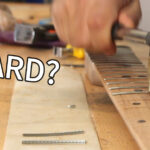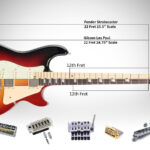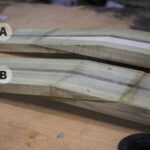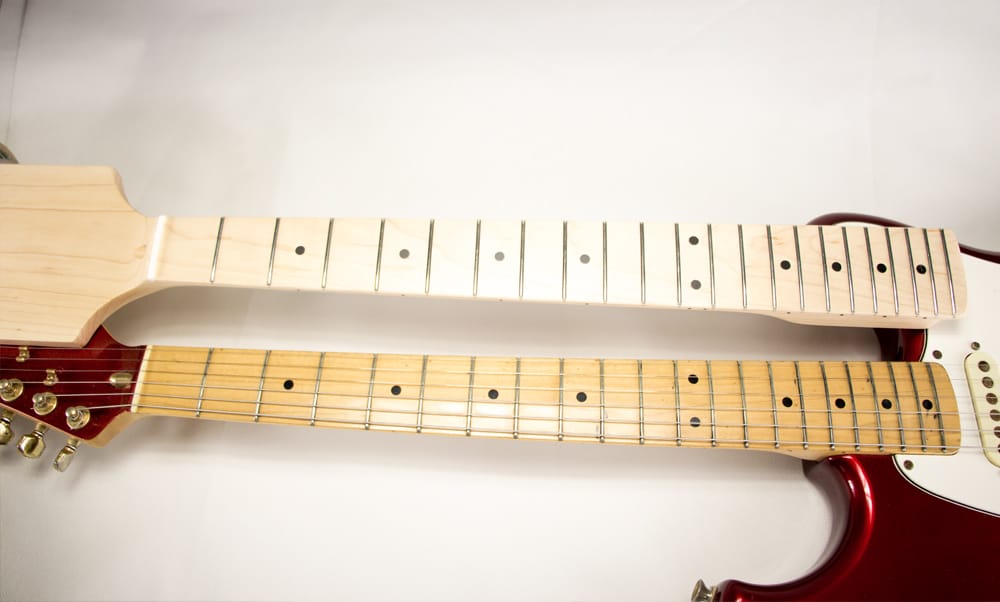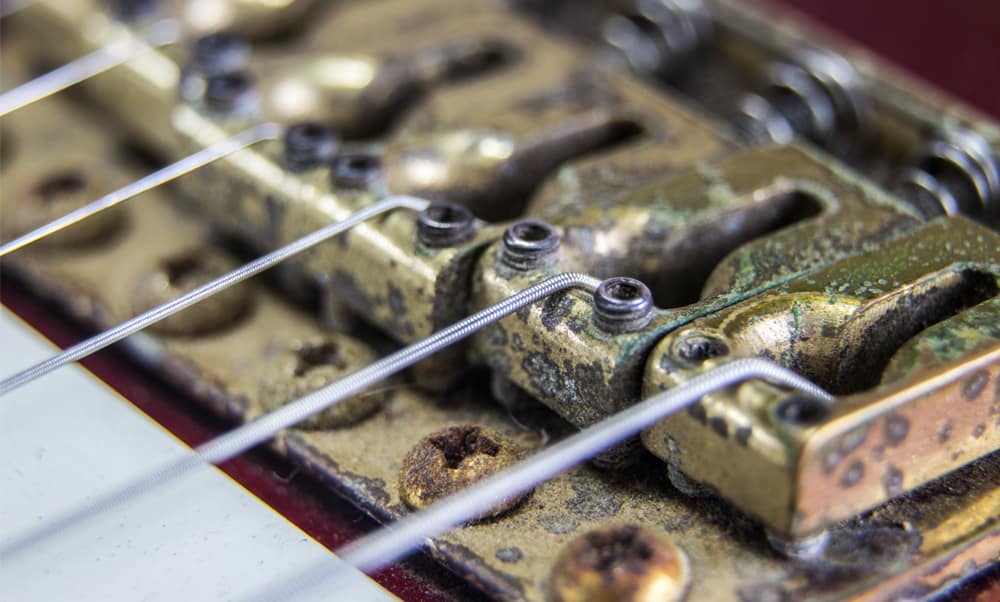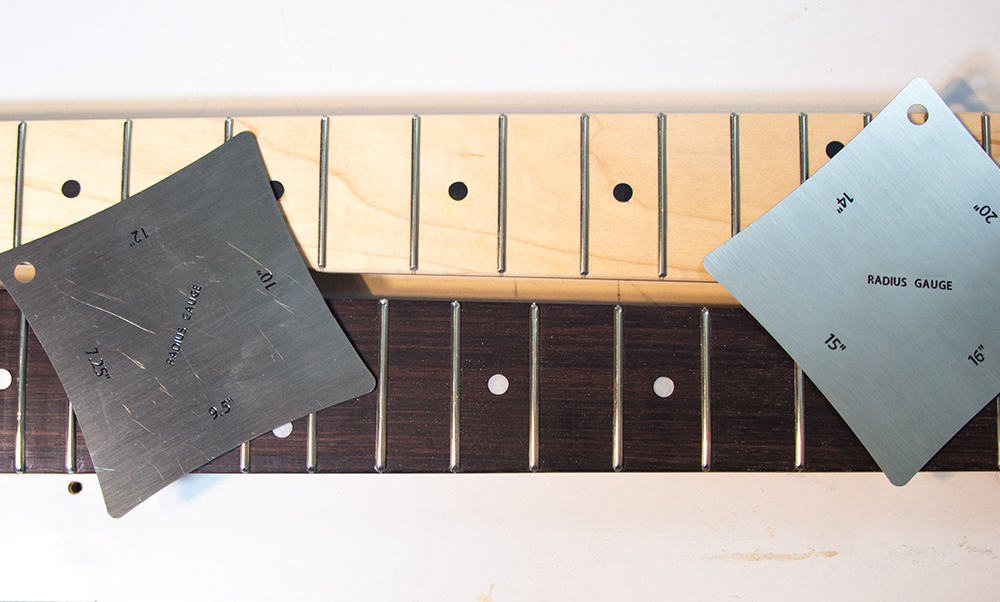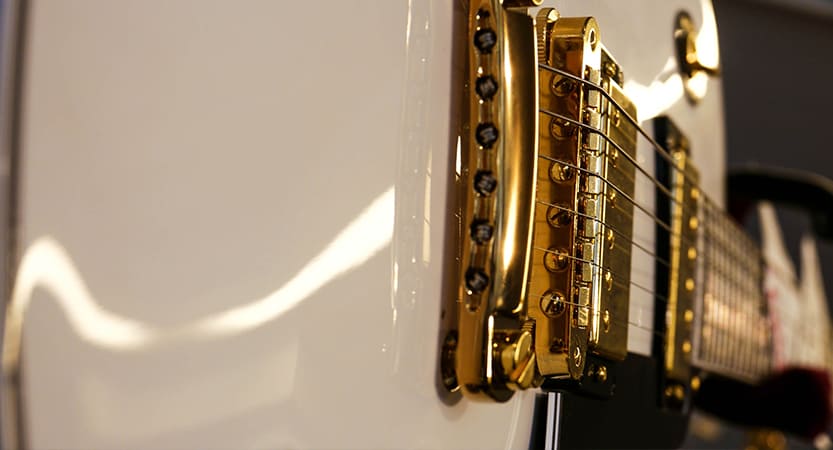It’s not outlandish to assume that strings are the only things that need to be replaced on your guitar; if you take really good care of it, it’s not unlikely that it’ll stay in one piece through its lifetime. However, accidents happen, and parts of your guitar can get damaged and need replacing. The guitar neck is one of the parts which more frequently needs replacing, and we’re here to let you know some things to streamline the process.
What are the things you need to know about guitar neck replacement?
- It may involve measurement and even some woodwork.
- Always be patient to avoid critical errors.
- Replacement neck specifications should match the original as close as possible.
- Scale length and fret count are crucial when ordering a replacement.
- Replacement may get a little complicated, but with the proper precautions it is achievable.
- Ensure the replacement neck’s profile is to your taste.
When considered before a replacement is ordered, these tips can save a lot of hassle. Replacement necks are widely varied, and if you’re not willing to do some modification, they can be highly specific. Let’s talk about a few things which can make guitar neck replacement so much more straightforward.
Why Replace a Guitar Neck?
There are numerous things that would prompt replacing a guitar neck, whether it is an old guitar or not.
Worn-out frets
Aged guitars are subject to certain types of damage purely due to their age and the wear-and-tear of the materials that make up the guitar. Guitar frets, despite being metal, are not exempt from this. The constant pressure of the strings on the frets over years causes grooves which can reduce the effectiveness of the fretting action. The neck can be refretted, but it may be a better option to replace the whole neck particularly if the guitar is older.
Cracked or broken neck
Regardless of the guitar’s age, all it takes is a forceful accident to damage the neck. While it is entirely possible to repair a fractured neck, even if it’s completely separated, the structural integrity is never the same with just adhesive. If that is a concern, it is preferable to replace the entire neck.
Worn-out fretboard
The constant action of the fretting fingers on the fretboard can have a lasting effect on the wood, particularly cosmetically. Although some people embrace the worn-out appearance, if you’re not a fan of the discoloured spots on your fretboard, replacing the neck is a good option.
Warped neck
Guitar necks can sometimes be warped, with a back-bow or an intense up-bow, and remain that way even after truss rod adjustment. This can be due to humidity or heat, the wood itself, and even the effect of the strings over time. A guitar with a warped neck will never sound as good as it should, and is sometimes impossible to remedy. In these cases, the neck needs to be replaced.
Cosmetic changes
It is a possibility that a guitarist may simply want to change their guitar’s neck purely for the sake of aesthetics. Premium guitar necks offer a wider range of woods, some of which are exotic and have a stunning appearance. Using such a rare wood would improve the aesthetic appeal of a guitar greatly.
Change it up
A guitar neck is not all about the functionality of providing the fretboard and tethering the strings. The neck affects the handling and playability greatly. The profile, for instance, significantly affects how you handle the guitar and reach for frets. Sometimes a new neck is warranted to improve playability. In a situation where you get a fantastic guitar with a poor neck, or even an old neck that you’re just too used to, you can just swap it out to change the experience. When it comes to playability, replacing a guitar neck is almost comparable to replacing the whole guitar.How to Replace a Guitar Neck
Guitars can have either set or bolt-on necks. Set necks are not easily replaced by even skilled guitarists and are best left to the expertise of luthiers. Bolt-on necks are rather easier to replace. The following is a simplified guide to replacing a bolt-on neck:
- The first thing that must be done when attempting to replace a guitar neck is to unstring the guitar.
- The neck must then be unscrewed from the body at the heel region. After unscrewing, the neck can be freed of the pocket.
- Ensure that your replacement guitar neck has a suitable heel for the pocket of the guitar. Otherwise, be prepared to make some adjustments. The replacement guitar neck should also have an identical scale length and number of frets to ensure perfect intonation.
- Fit the replacement neck in the pocket, and hold it with a clamp to keep it in place.
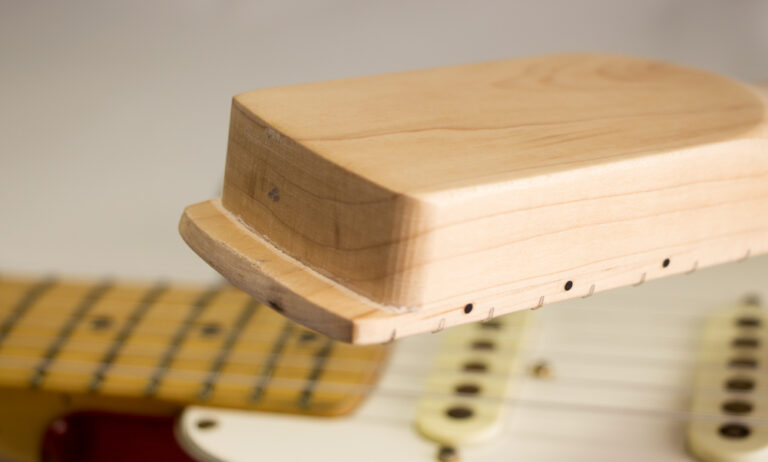
- You will need to drill holes into the guitar neck when it is clamped into position. These holes serve to screw the neck to the body of the guitar.
- Once the holes are drilled, the plate can be replaced and the neck screwed in.
Types of Guitar Necks
Guitar necks can be classified by some different properties such as the wood they’re made of, the neck scale, and the neck profile.
Guitar Neck Woods
Different woods give different feels and different tones, but the choice comes down to preference. Examples include maple, cherry, and mahogany. Rosewood, ebony are more common for fretboards.
Guitar Scale Length
The neck scale length is basically the distance from the nut of the guitar to the bridge. The scale of a guitar can be determined by calculating the distance from the 12th fret to the nut or the bridge, and then doubling the value obtained. Both values should be equal. Neck scale is an integral statistic when replacing a guitar neck, and the neck scale should be the applicable for the specific guitar.
Neck Profile
The profile of the neck, or the radius, is basically the cross-sectional shape of the underside of the guitar neck. The types are named after the shape the curvature takes, which can be either ‘C’, ‘V’, or ‘U’. There is no best neck profile, as it all comes down to which the guitarist is most comfortable with. Some guitars have the neck start off as one profile and then gradually shift to another type at the other end. These necks are known as compound radius necks.
Set Necks Vs Bolt-On Necks
Set Guitar Necks
Almost all Gibsons are built with set necks, which are necks that are kept in place with only a clever joint and some glue. Due to this transition of wood to wood, the tone of set neck guitars tends to be richer and more resonant. Due to the seemingly permanent set-up however, set necks are much more complicated to replace and usually require the services of a luthier.
Bolt-On Guitar Necks
Fender pioneered the bolt-on neck style in the 50s, which made production and repair much easier. The metallic element to a bolt-on neck and the break in the wood contact push guitars with a bolt-n to produce brighter tones. The major advantage to a bolt-on neck is the ability to replace it so much easier than with a set neck.
Can a Guitar Neck Type Be Converted?
The choice of neck is typically restrained to the guitar and whatever type of neck it was originally built for, however, it is actually possible to convert one neck type to the other although that can be a complex procedure.
What Type of Heel Do You Want?
The guitar neck’s heel is the point at which the neck joins the body. The heel is essentially the joint for the guitar’s necks. The heel is on the neck while the pocket is on the body. It should be noted however that even though two different necks may be similar, their heels may differ.
Heel Compatibility
You must ensure that the heel of the neck that is replacing your old one has a heel that is a compatible fit for the pocket on the body of the guitar. You will need to know whether you are going for a rounded or a flat heel. If you get a heel of the wrong type, it is actually possible to alter it with a bit of woodworking expertise. However, this manipulation may prevent you from getting the most for your money.
Some Shimming Required
After fitting the neck in the pocket, you may notice that the strings ride too high, even after adjusting the truss rod and saddles. In this case, you may need to shim the neck of the guitar to tilt the neck closer to the strings. Usually two to three degrees will do the trick.
What is a ‘shim’?
A shim is a small flat wedge which fits between the heel and the pocket of the guitar. You can purchase them or make them yourself. This will act to change the angle of the neck and reduce the action. A shim may also be used if the neck pocket is slightly to wide for the neck and you want a tighter fit.
Squier Vs Stratocaster Vs Telecaster
Depending on whether you own a Telecaster or a Strat, you may need to be precise with the type of necks you buy. A Telecaster neck has a flat heel while a Stratocaster neck has a rounded heel. Apart from that, the necks of these guitars share the same number of frets and an identical scale length and are for the most part the same.
Are They Interchangeable?
A Stratocaster heel can actually fit in a Telecaster pocket, however, it will leave unsavory gaps between the heel and the pocket. On the other hand, a Telecaster heel will never fit in a Stratocaster pocket. To get that to work, you must perform some modifications on the Telecaster heel.
Are Necks Built for Squier Compatible with Fender Bodies?
Squier is a sub-brand from Fender which essentially produces budget variants of their guitars. Regarding Squier necks and necks for Fenders like the Stratocaster and Telecaster, Squier necks for the most part fit well. However, some builds can be just a little too tight or too loose, and as such it is recommended to measure accurately beforehand and make adjustments as necessary.
Scale Length and Fret Number
Scale Length
The scale length of a guitar neck is the distance between the edge of the nut and the edge of the bridge, right where the strings come off the string saddles. That may sometimes be quite arduous to measure, so an easy way to measure your scale length is to measure from the nut or the bridge to the 12th fret and multiply by 2. That is how to get the scale length of your guitar neck, which is very important when replacing the neck. You must ensure that a replacement guitar neck has the same scale length as the older one.
Fret Number
The fret number is simply the number of frets on the neck of a guitar. This is also an important value when it comes to replacing your guitar’s neck. The number of frets can completely alter the intonation of the guitar if it is not about right, so ensure that the scale length is equal from 12th fret to bridge and nut. This may sometimes involve some woodwork to get it just right.
Premium Neck Replacements
A lot of companies offer their own custom guitar necks. Some of these companies sit in the premium segment, with prices that might be too high for the average player. However, premium necks tend to have a better build, with more expensive woods and materials, and expert craftsmanship.
What Are Good Premium Brands?
The best premium necks for your guitar are typically the necks from manufacturers like Fender and Gibson, although with the premium quality comes premium price. These guitar necks have prices above $300 on average. Third-parties like Warmoth offer extensive customization on the necks they offer but as the custom options pile on, the prices go north of $500. byoguitar have a nice variety of Original Fender Necks
Necks on a Budget
Purchasing a guitar neck for premium prices is not for everyone. Sometimes it’s just not worth spending so much money, yet a neck replacement is still due. There are a lot of budget options for guitar necks out there.
What Are Some Good Budget Brands?
• When it comes to budget neck options, Chinese manufacturers give the widest selection. Platforms like Alibaba have an array of choices. A notable Chinese manufacturer of budget guitar necks is Kmise. Kmise guitar necks can be bought for around and under $50, which is fantastic, and if you’re patient enough to wait for shipping directly from China, you can get even better deals.
For higher reliability and faster shipments there are companies such as the Canadian solomusicgear.com with a range of generic necks from around $50 and to original Fenders.
Check my post called ‘Buy a Cheap Guitar Neck and Make it Amazing’.
The guitar neck is one of the most prominent parts of the guitar, holding the fretboard which is an integral part of the system. Guitar necks can go through a lot of stress and damage, and in the case they ever need replacing, the right decisions are now crystal clear.
Related Questions
How to keep guitar neck aligned
If a guitar neck begins to curve forwards or backwards, it is known as an up-bow and back-bow respectively. The metal rod in the neck of the guitar, the truss rod, assists in counterbalancing the string tension. Tightening your truss rod helps correct up-bow, while loosening corrects a back-bow.
How to replace acoustic guitar neck
Unless it is a rare case of a bolt-on, acoustic guitar necks are best left to experienced luthiers to replace. Removing a set neck involves soaking and softening the glue, which can involve an amount of technique which may be beyond the skill of the average guitarist.

